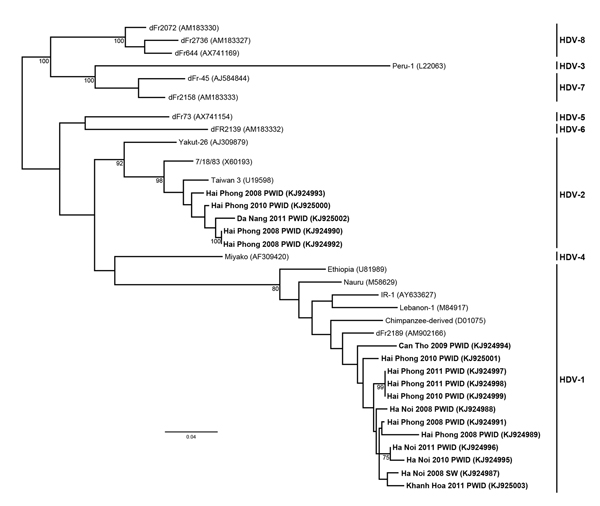Volume 21, Number 3—March 2015
Letter
High Prevalence of Hepatitis Delta Virus among Persons Who Inject Drugs, Vietnam
Figure

Figure. Maximum-likelihood phylogenetic tree of hepatitis delta virus (HDV) genotypes 1 and 2 from Vietnam. A 472-nt fragment (corresponding to nucleotides 802–1,273 from HDV isolate C15; GenBank accession no. KF660600) was used to construct the phylogram. HDV genotyping was done by using amplification and bidirectional sequencing of the R0 region as described by Le Gal et al. (2). Bootstrap resampling was done for 1,000 replicates of the dataset using the neighbor-joining algorithm; values >70% are shown at the nodes. Bold text indicates samples from patients in Vietnam; location, year, and risk group are indicated. Genbank accession numbers are shown in parentheses. Scale indicates substitutions per position. PWID, person who injects drugs; SW, sex worker.
References
- Taylor JM. Virology of hepatitis D virus. Semin Liver Dis. 2012;32:195–200 . DOIPubMedGoogle Scholar
- Le Gal F, Gault E, Ripault MP, Serpaggi J, Trinchet JC, Gordien E, Eighth major clade for hepatitis delta virus. Emerg Infect Dis. 2006;12:1447–50. DOIPubMedGoogle Scholar
- Sakugawa H, Nakasone H, Nakayoshi T, Kawakami Y, Miyazato S, Kinjo F, Hepatitis delta virus genotype IIb predominates in an endemic area, Okinawa, Japan. J Med Virol. 1999;58:366–72. DOIPubMedGoogle Scholar
- Casey JL, Brown TL, Colan EJ, Wignall FS, Gerin JL. A genotype of hepatitis D virus that occurs in Northern South America. Proc Natl Acad Sci U S A. 1993;90:9016–20. DOIPubMedGoogle Scholar
- Nguyen VT, McLaws ML, Dore GJ. Highly endemic hepatitis B infection in rural Vietnam. J Gastroenterol Hepatol. 2007;22:2093–100. DOIPubMedGoogle Scholar
- Tran HTT, Ushijima H, Quang VX, Phuong N, Li TC, Hayashi S, Prevalence of hepatitis virus types B through E and genotypic distribution of HBV and HCV in Ho Chi Minh City, Vietnam. Hepatol Res. 2003;26:275–80. DOIPubMedGoogle Scholar
- Dunford L, Carr MJ, Dean J, Nguyen LT, Ta Thi TH, Nguyen BT, A multicentre molecular analysis of hepatitis B and blood-borne virus coinfections in Viet Nam. PLoS ONE. 2012;7:e39027. DOIPubMedGoogle Scholar
- Sy BT, Ratsch BA, Toan NL, Song LH, Wollboldt C, Bryniok A, High prevalence and significance of hepatitis D virus infection among treatment-naive HBsAg-positive patients in Northern Vietnam. PLoS ONE. 2013;8:e78094. DOIPubMedGoogle Scholar
- Sy BT, Nguyen HM, Toan NL, Song LH, Tong HV, Wollbolt C, Identification of a natural intergenotypic recombinant hepatitis delta virus genotype 1 and 2 in Vietnamese HBsAg-positive patients. J Viral Hepat. 2015;22:55–63 . DOIPubMedGoogle Scholar
- Hughes SA, Wedemeyer H, Harrison PM. Hepatitis delta virus. Lancet. 2011;378:73–85. DOIPubMedGoogle Scholar